Return to the Lecture Notes Index
15-111 Lecture 24 (Monday, March 23, 2009)
Heaps
A heap is a tree structure where the relationship is between the parent
and its children. In a min-heap, the parent always has a
smaller value than its children (there is no ordering among the children
themselves), so the minimum value in the tree will be at the root. In
a max-heap, the parent always has a greater
value than its children, so the maximum value in the tree will always be
at the root. This property allows us to efficiently implement a
priority queue, which is a queue where the item with the
highest priority is dequeued first. (A normal FIFO queue is like a
priority queue where items that were entered first have higher priority.)
In addition to the relationship between the parent and its children, we
will impose another property on heaps. Heaps will always have to be full
trees -- that is, there must be no holes at any depth except for the
greatest depth, and all of the holes at the greatest depth are to the
right. (That is, we will fill the tree from top to bottom, and from left
to right.) This restriction on the shape of the tree will make our
implementation easier and more efficient, as we will see later.
Inserting Into A Heap
When we insert into a heap we need to make
sure that the resulting structure is still a heap. So the resulting
structure needs to maintain the relationship between each node and its
children, and the resulting tree cannot have any holes in it anywhere
except for the bottom right of the tree. We will always initially use
the first available spot (the leftmost open spot at the bottom of the
tree) to initially insert the new item into the heap, so the tree will
continue to be full after we insert. But will it still be a heap?
Let's look at an example of constructing a min-heap:
We will begin by inserting 70 into the heap. Since this is the first
item in the heap, it will have to be the root.

Next, we will insert 150 into the heap. Since the tree is full at depth
1 (the root), we will insert it in the leftmost spot at depth 2, which in
this case is the root's left child. Since 70 < 150, this is still a heap.
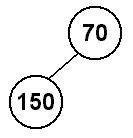
Now we will insert 110 into the heap. The next available spot to add an
item to the heap is roots right child, so we will add 110 there. This
is also still a heap because 70 < 110. (Remember, it does not matter how
the siblings relate to each other.)
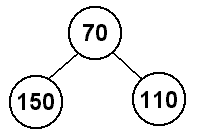
Next, we will insert 80 into the heap. Since the tree is now full at depth
2, we will add 80 at the leftmost spot at depth 3 (150's left child). This
presents a problem, though, because 150 > 80, so we no longer have a heap.
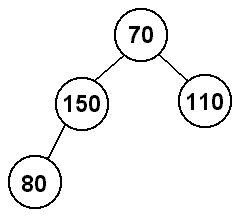
How do we make this a heap again? Whenever we insert, we have to look at the
new node's parent and check the relationship. If the new node is smaller than
its parent (in a min-heap), then we will swap the two values. After we have
done this, we then have to check if the new one is smaller than its new parent.
We continue this process of checking and swapping until we either hit the root
or reach a spot where the new value is greater than its parent, because in
either case we will have a heap again.
So, when we insert 80, we will have to swap it with the 150 since 150 > 80.
80's parent will now be 70, so we will stop there since 70 < 80.
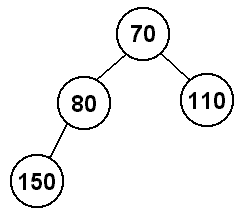
Now let's add 30 to the heap. This will start in the second spot at depth 3
(80's right child), and then will have to swap with 80 because 80 > 30, and
then will also swap with 70 because 70 > 30, so here 30 will become the new
root of the heap. This is consistent with our idea of a min-heap, since 30
is now the smallest value in the heap.
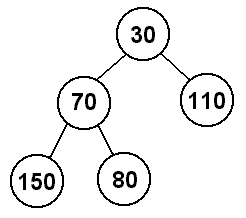
Finally, we will add 10 to the heap. It will start in the third spot at
depth 3 (110's left child), and we will have to swap it with 110 because
110 > 10, and then we will also have to swap it with 30 because 30 > 10, so
now 10 becomes the root of the heap.
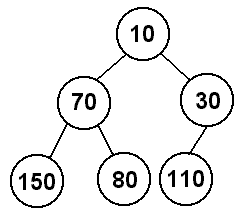
So, when we insert something into the tree, we initially place the item
in the bottom, leftmost spot in the tree, and then swap the new value with
its parent until we once again satisfy the properties of the heap.
Removing From A Heap
When we remove an item from the heap, we will always take the value at the
root. Why? The reason we use a heap is to have easy access to the item
that has the highest or lowest value in the current set of items. Like the
stack and the queue, limiting the possible behavior of the heap ensures that
it will behave consistently.
When we remove the item at the top of the heap, we leave an empty spot.
Since the heap cannot have any holes in it except at the bottom-right, we
no longer have a heap, so what can we do to reestablish a heap?
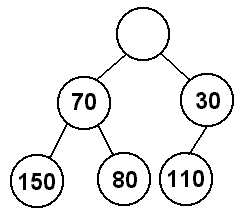
Now the idea is to recreate a heap. The easiest way is to move the last item in the heap to the top.
In this case, that means that 110 will be moved to the root of the heap.
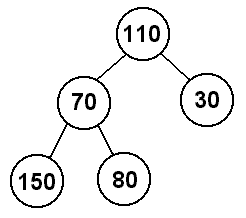
Now this is clearly not a heap, so we will percholate 110 down through the heap to fix it. We have to check which of the children is smaller and swap them.
Clearly 30 is the smaller value, so 110 and 30 will swap.
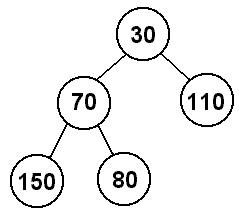
And now it is a heap again. This is a successful removal.
Implementing A Heap With A ArrayLists
Up until now, we have been talking about heaps as trees, but how would we implement
them? Using a tree to implement the heap leaves us with some questions that have
difficult answers. How do the children know who their parent is? How do you keep
track of where the next item should be added? In order for children to interact with
their parent, we would have to use recursion to go down a path, and then as the
recursive calls unfold swap back up the tree to restructure the heap. To keep track
of where the next item should go, we could keep a count of the number of items in the
heap, and use that number to construct the path down the tree to insert.
Both questions have reasonable answers, but in practice they require complicated code
in order to work correctly.
So if we are not going to store the heap as a tree, how should we store it? Before we
decide how to store it, let's number the spots in the heap as follows:
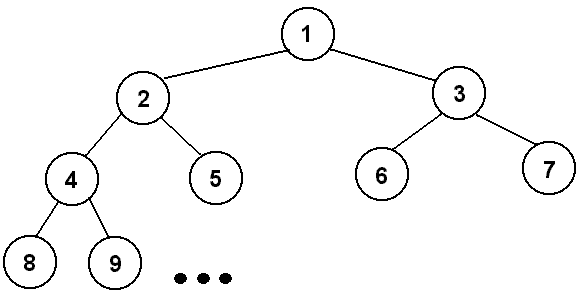
We have numbered the items in the heap from top to bottom and from left to right with
no gaps in the numbering. These should resemble indexes for the spots in the Heap.
The indexes themselves are not what makes this numbering system so valuable. If you
look closely, you will notice the following two relationships: the left child's index
is exactly twice the parent's index, and the right child's index is twice the parent's
index + 1. This means that we can easily get from the parent to one of its children, and
we can also easily get from the children to the parent by simply dividing by two. This
relationship between the indexes is what makes it possible for us to implement our heap
using an ArrayList.
When we numbered the items in the heap, we started with the root at 1 rather than 0. This
simplifies our math considerably, but if we are using a ArrayList indexes start at 0. What
should go in index 0 if the root is at index 1? The easiest solution is to just throw a
"null" into index 0 and effectively throw that part of the ArrayList away. We could start the
root at 0, but that complicates the math, and throwing away one index in a ArrayList is not
really a significant waste of memory.










